Use 'Print preview' to check the number of pages and printer settings.
Print functionality varies between browsers.
Printable page generated Friday, 26 April 2024, 6:08 PM
Study Session 13 Sustainability of WASH Services
Introduction
You have already learned that WASH situations in urban communities change over time for reasons such as continued urbanisation, population growth and changing lifestyles. You have also seen that stakeholders seek to improve the WASH situation through planning and implementing interventions and hence contribute to improvements in health and wellbeing.
There is one single key concept that all WASH stakeholders should aim to embed in their activities. That is, to ensure that their activities will always result in long term benefits to the environment and communities living in it. This study session will introduce to you what this sustainability means in practical terms.
Learning Outcomes for Study Session 13
When you have studied this session, you should be able to:
13.1 Define and use correctly each of the key words printed in bold. (SAQ 13.1)
13.2 Explain what is meant by sustainability. (SAQ 13.1)
13.3 Explain the key factors contributing to sustainable WASH service delivery in different stages of a project. (SAQ 13.2)
13.4 Describe how access to facilities can positively or negatively influence community’s behaviour in safe hygiene and sanitation practices. (SAQ 13.3)
13.5 Demonstrate how governance can positively and negatively affect sustainability. (SAQ 13.4)
13.1 The concept of sustainability
You were introduced to the idea of sustainability in Study Session 10 where it was defined as the ability ‘to last or continue for a long time.’
As simple as it seems, the concept of sustainability is actually quite complex. Sustainability in a WASH context involves many different inputs and links between causes and effects. An intervention or activity in one area affects not only that community, but also the people living far away. For example, a town that uses a river as its water source may suffer if the water is contaminated by a community located upstream who have poor control of waste collection and disposal. What happens in one place can have an effect on another, even if it is a distance away.
Similarly, what happens at one point in time has an effect on the period that follows. How our forefathers fulfilled their energy needs has affected the environment we live in today. How we look after our water resources affects sources of water available for coming generations. When a community decides to end open defecation, they are improving their own health and also the future health of the whole community, including the children.
Sustainability of WASH in urban areas is further complicated by competing demands for resource. Water is a critical resource for communities, as it is for hospitals and schools, industries, businesses and agriculture. As competition and the demand for water increases, sustainability of sources becomes more difficult to guarantee. Ensuring sustainability requires substantial work towards improved care of resources and responsible use by all stakeholders.
Sustainability is a concept used to ensure that activities – regardless of the place or the time they happen – result in a long-term positive impact on the environment and its inhabitants, or at least do not have negative impacts. Urban communities are part of a larger national community, and are also part of the community of the world as whole. The concept of sustainability helps us to think locally, nationally and globally, when planning interventions.
What do you understand by the word sustainability in the context of planning urban WASH activities?
Sustainability means that the WASH activities would be planned with consideration for the long term benefits to the environment and communities living in it both now and in the future. By environment we mean the larger environment including nearby towns and villages. By communities, we mean everyone in them.
13.2 Sustainability of WASH facilities
In making WASH facilities sustainable, we mean that the concepts described above are taken into consideration to ensure that facilities function properly for long periods. WaterAid (2011) uses this definition:
Sustainability is about whether or not WASH services and good hygiene practices continue to work and deliver benefits over time. No time limit is set on those continued services, behaviour changes and outcomes. In other words, sustainability is about lastingbenefits achieved through the continued enjoyment of water supply and sanitation services and hygiene practices.
For numerous reasons, urban areas do not always get adequate access to WASH facilities. Where facilities are not functioning properly, even for a short period, the lives of communities are immediately and severely affected. The hygiene and sanitation conditions of individuals or families can rapidly worsen if WASH facilities are poor, exposing them to significant health risks. Lack of nearby clean water means communities have to use water from further away, which may become contaminated during transport and handling. This increases the risk of exposure to waterborne diseases. Figure 13.1 shows the familiar sight of water being carried because no water supply is available in the home.
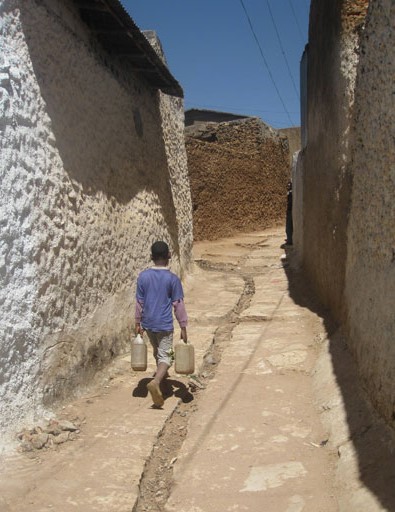
Sustainable facilities, i.e. facilities that operate continuously and fully for a long time, are required to safeguard the safety and health of urban communities. Thus building WASH facilities alone is not enough. It is equally important to embed strong measures to ensure their sustainable operation during the full project cycle.
The project cycle is the term used to describe the life of a project. It consists of three stages, the planning stage, the construction stage and the post-construction stage. It is common to think that sustainability of facilities is only a concern during the last stage of the project, when communities will actually be using the facilities – but this is not correct. It is impractical and illogical to expect facilities to last for a long time if measures are not taken during the planning and construction stages to ensure that they can. Table 13.1 summarises the key factors to be considered at each stage of a project cycle to ensure sustainability.
| Planning stage | Construction stage | Post-construction stage |
| Participatory planning: Users must participate in planning so their opinions, interests and needs are addressed. | Site selection: Location is crucial because it affects accessibility. Consultation is essential to find and agree on a suitable location. | Management: Ensuring proper management of WASH facilities is essential. This needs an effective management body, with adequate capacity building and sound financial management. |
| Socially inclusive planning: WASH facilities should be planned with all sectors of the community in mind, including the poor, elderly, disabled and children. | Construction management: Close supervision of quality of materials, timely progress of construction and completion in the proposed time and within budget. | Operation and Maintenance: Establishing a system for timely, efficient and cost-effective maintenance is essential so that breakdowns are prevented. |
| Technology choice: Technologies used in providing WASH facilities should be easy for the community to understand, use and maintain. | Functionality (review of designs): The design and engineering of the project must be appropriate and function correctly. | Good governance and social accountability: Continued support to the community and management body is required to ensure financial sustainability, build strong local capacity to replicate or expand the facilities and ensure that existing facility can be replaced when the service period ends. |
The sustainability of WASH facilities and services will be affected by how well the factors summarised in Table 13.1 are considered and acted upon. Summarise the key factors contributing to sustainable WASH service delivery in each of the three stages of the project cycle.
The answers are as follows:
- During the planning stage: Participatory planning, socially inclusive designs and technology choice.
- During construction stage: Location (site selection), quality assurance (effective management during construction) and focus on functionality.
- During post-construction stage: Management, operation and maintenance and governance.
In the next sections we will examine three important dimensions of sustainability in urban WASH services to be considered at all three stages of project implementation – namely sustainable behaviour, financial sustainability, and good governance and social accountability.
13.3 Encouraging sustainable behaviour change
In Study Sessions 9 and 10, you learned about influencing behaviour in relation to improved sanitation and hygiene practices. Here we will consider how such behaviour change can be sustained.
The objective of any WASH promotion activity or intervention should be to ensure that achieved changes in behaviour are deeply rooted in the social and economic values of the community, rather than being temporary. In this way, behaviour change in communities resulting from promotion activities can potentially be sustainable.
To encourage sustainable behaviour change, interventions should be planned and implemented with sustainability in mind. Monitoring and follow-up mechanisms should be put in place to ensure that communities do not revert back to old practices. In Section 13.2, we mentioned factors that affect sustainability of WASH facilities in terms of planning, construction and post-construction stages. You can see in Table 13.2 that a similar concept applies to sustainability of WASH promotion and behaviour change interventions.
| Planning stage | Implementation stage | Post-implementation stage |
| In-depth assessment of existing situation: Before planning a promotion activity, investigate the existing level of knowledge, attitudes and hygiene practices. | Participatory implementation: All key sectors of the communities should be involved, allowing for possible adjustments in approach and methodology to ensure even stronger sustainability. | Monitoring for impact: Once promotion activities are completed, monitor changes in behaviour and consider messages for subsequent interventions. Monitoring also provides the basis for reinforcement in communities and advocacy with local government. |
| Communication strategy (channels, materials, agents): Based on assessment, identify preferred communication channels. Develop communication materials to disseminate messages through preferred and high impact channels. | Focus on families, particularly mothers: Working with mothers and school children for behaviour change helps improve and sustain impact in community-wide behaviour change. | Repeating the cycle: There is usually more than one behaviour to try to change in communities. Repeat the process from planning stage, to work on additional behaviour that was not addressed in previous phase. |
| Participatory planning: As in facility construction, ensuring participation, involvement and commitment of all stakeholders is crucial. | Focus on one message at a time: Hygiene and sanitation promotion work should focus on one behaviour at a time, rather than on multiple messages, to maximise the chance that behaviour change is sustained. | Reinforcement: Organise events at suitable intervals to reinforce messages, e.g. sanitation campaigns, street role-plays by students. |
One key consideration during the planning stage is the availability of adequate, well-functioning WASH facilities in the community. Promoting behaviour change in situations where there is no access to facilities is always challenging and rarely successful. Communities may agree to change their practice as a result of the communication work. However, if they do not have the means to actually practise the behaviour change, the work will be in vain.
You will remember from Study Session 8 that there is a wide range of determinants that will affect the behaviour of communities. The importance of WASH promotion is to bring about behaviour change in communities by creating adequate knowledge of safe hygiene behaviours and encouraging the necessary conditions for their full practice by all members of the community.
Describe how access and condition of facilities can influence school children’s behaviour in safe hygiene practices (a) where facilities are good, as shown in Figure 13.2 and (b) where facilities are poor and dirty, as shown in Figure 13.3.
The answers are as follows:
- a.Where facilities are clean, accessible and functional school children can practise what they learned and make changes in their day-to-day behaviour. Access to well-maintained facilities positively influences their behaviour.
- b.Where there is lack of access or facilities are not kept clean, school children will not be able to practise the learned behaviour – however good the promotion work. The result will be an increase in awareness, but not a practical change of behaviour. If there is no access to well-maintained facilities behaviour change in school children will be negative rather than positive.
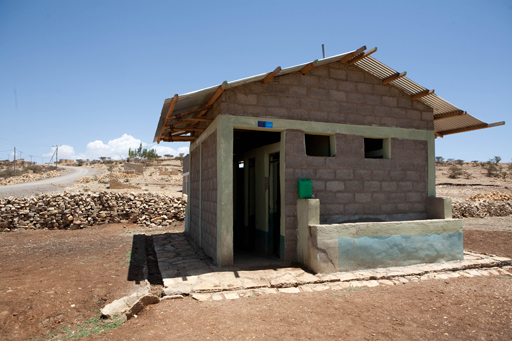
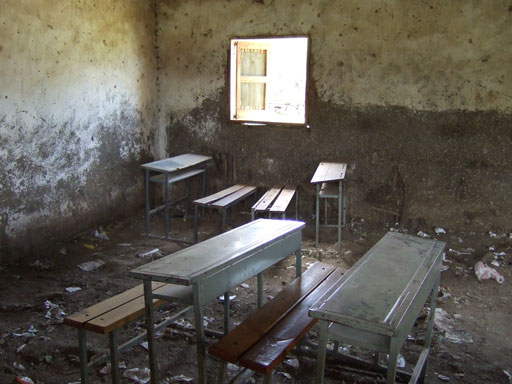
You may find that even where hygiene promotion activities are undertaken and WASH facilities are adequate and functioning, communities are still not applying safe practices. This is a critical challenge encountered during behaviour change activities, underlining the need to remind communities continuously about safe practices until the desired behaviour becomes habit. Both the presence or absence of facilities and also the will to use them, can be critical factors to identify as opportunities for, or threats to, sustainable behaviour change.
Look at Tables 13.1 and 13.2 and compare them. What similarities and differences can you identify?
The tables are similar in that they both refer to factors affecting sustainability of WASH facilities at three distinct stages of a project cycle. They are different in that Table 13.1 summarises the facilities, whereas Table 13.2 summarises information relating to the user communities.
Improving facilities and influencing people’s behaviour are interventions that mutually reinforce the improvement of WASH situations in communities. They can be most effective when undertaken simultaneously.
13.4 Financial sustainability of WASH services
As you can see in Table 13.1, finance is a key determinant in the sustainable operation and utilisation of WASH facilities. All WASH facilities, once in operation, require proper care and management. If they are to provide long-term service and hence be sustainable, adequate finance is required.
Financial sustainability refers to the ability to generate adequate revenue from provision of services, in order to cover expenses and generate additional money for future needs. In simple terms, there must be more money coming in than there is going out.
The managing body of a facility should ensure people are nominated to looking after it over its service life. Some should look after the day-to-day operation and others provide maintenance when the need arises. These people need to be paid. Some maintenance activities require money for the purchase of spare parts. Some facilities require electricity and water, which need to be paid for each month. For some facilities it may also be necessary to recover all or part of the initial cost of construction. For example, urban water utilities are expected, by law, to fully recover their initial investment cost over the service life of the facility.
All these expenses must be covered if a facility is to provide continuous service to users. If maintenance technicians are not paid for their work, the facility will be poorly maintained. As a result the facility will provide only a reduced service or may fall into disrepair. If electricity and water bills are not paid, a public latrine will soon be without light and flushing water. In short, without the ability to cover costs and expenses WASH facilities cannot be sustained. Conversely, if adequate money is generated to cover expenses, the facility will be able to provide long-term and full capacity service because an appropriate level of care and maintenance can be provided.
WASH facilities are usually designed and operated in such a way that that they can generate income (revenue). The income is collected from users, who may be individuals in the community, companies and organisations. These users may pay for the services they get on a regular basis or per use. A group or company is established to manage the facility, its revenues and expenses. For example, a private company may take on a contractual agreement with a municipality to manage a public latrine. Urban water utilities oversee the management and operation of water supply and liquid waste disposal in towns and they have the right to collect money from users for the services their facilities provide.
What do you think happens if financial sustainability is not achieved and maintained?
Where revenues collected are not adequate to cover the running costs including salaries of employees and other miscellaneous expenses, the facility will reduce its service level and eventually stop functioning.
Financial sustainability should be considered at the planning stage and carefully implemented throughout the rest of the project cycle. An important part of financial sustainability is setting an appropriate tariff. The tariff is an amount of money that a user pays for a single unit of service. For instance, a utility may set a tariff of Birr 2.50 per cubic metre of water provided. A public shower operator may set a tariff of Birr 5.00 for a single use. Similarly, organised youth groups may set their own tariff to households that use waste collection and disposal services they have set up.
During the planning stage, different tariff rates for services should be compared with the estimated expenses to decide if the facility can be financially sustained. Tariffs should also be set to ensure than the poorest users will be able to afford the cost. Regrettably, the poorest people have not always benefitted to the same extent as the better off from WASH developments in either urban or rural settings in many countries.
During the construction and post-construction stages, costs should be kept to a minimum. If expenses rise, the tariff will have to be increased so that financial sustainability is maintained.
Urban communities, as users of these facilities, should be aware of this concept and willing to pay for services they are getting. Paying is the only way to guarantee that services will continue to be available. As you learned in Study Session 6 and in Study Session 11, community engagement and community mobilisation are used to ensure urban communities understand their role and contribution in sustaining WASH services.
Now read Case Study 13.1 and answer the question that follows.
Case Study 13.1 Emanuel public facility
Emanuel public facility is located in Akaki, a sub-city of Addis Ababa (Figure 13.4). The facility provides services of latrine, shower and cafeteria to the surrounding community. The facility has a biogas digester which uses the excreta collected in the latrines and most of the organic waste from the kitchen to produce biogas. The gas is used in the kitchen for cooking food using a stove similar to the one shown in Figure 13.5. The facility also uses electricity to supplement its energy needs. The main users are visitors to the nearby market.
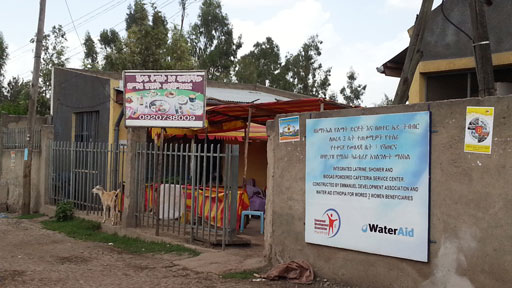
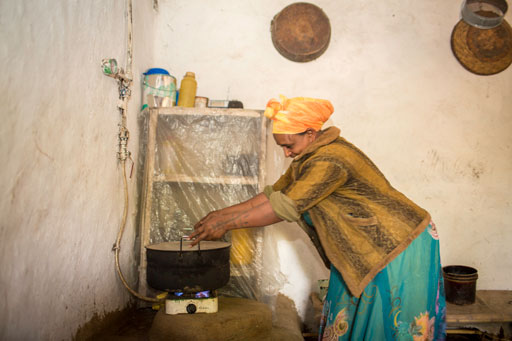
The facility is managed by a group of women who have received training and support on the sustainable use and management of the facility.
The chairwoman of the group reports that they have made an effort to ensure profitability by setting tariffs for users. They have ensured continuous investment in maintenance (e.g. timely desludging of slurry from the digester), reduced incidental costs by avoiding use of external labour and doing most of the work themselves, and minimised recurrent costs including their own salaries.
Today, two years after the start of their small business, the facility generates more revenue than expenses and has proved to be financially sustainable. As a result, the group has ventured further and have started up an additional small restaurant business in a different location.
What additional factors would need to be taken into consideration to ensure continuous functionality of this facility in the long term?
It would be sensible to set aside money to pay repair costs in the event of a major breakdown, for example if the digester develops a leak or other unforeseen problem.
13.5 Good governance and social accountability
WASH facilities and services are provided as a result of decisions made by those with leadership roles. These decisions include approval of plans, allocation of necessary resources for construction and enforcement of standards during construction and service periods. Such leaders also create and support management bodies for WASH facilities, establish tariff rates and manage revenues from WASH services. Decisions made by those who assume responsibility at different levels affect the sustainability of WASH services enormously.
As you learned in Study Session 1, governance refers to the interrelated parts of government systems through which decisions about services, in our case WASH services, are made and implemented. Governance can help improve WASH situations by providing resources and facilitating an appropriate environment for sustainable management. However governance can also negatively influence sustainability if poor decisions are made, or if there is a lack of transparency. If good decisions are made but poorly implemented or not explained clearly, this can also have a negative effect on the sustainability of WASH services.
You learned in Study Session 5 that social accountability refers to the requirement that leaders, decision makers and service providers have a responsibility to address the needs and priorities of service receivers, i.e. communities and users. The intensity of social accountability awareness in a town will be a major factor in determining the sustainability of WASH facilities and services. Strong social accountability ensures that resources are allocated to address the most pressing needs of a community and are utilised effectively for the intended purpose.
Good governance and social accountability go hand-in-hand. Good governance ensures the right decisions are made and are implemented as planned. Strong social accountability ensures that the decision making and implementation process is executed in a responsible manner.
Lack of good governance and/or absence of social accountability in local structures soon impacts on sustainability of WASH facilities and services. For instance, assume a decision is reached to raise the tariff for water consumption in a given service area of a water supply network. The community will naturally resist an increase in price. However, they may still be willing to pay the extra if they are confident that the management body came to a fair decision (good governance) and that all the revenue will be used to ensure a continuous supply of water in their taps (social accountability). However, if there is a history of resource abuse by the management body, the community will strongly resist an increase in charge and may refuse to pay at all. They will question the decision to raise the tariff, and they will object once the decision is implemented. The negative impact on sustainable service in such circumstances is clear.
The lack of equity in WASH service provision is one of the key challenges in urban areas. In this study session, you have learned about a number of reasons contributing to this, including both social and economic factors. The decision-making process also contributes to how information on equity is collected, analysed and used to reach appropriate decisions that serve the rights and meet the needs of under-served sectors of the population, particularly vulnerable groups, such as disabled people who are likely to find it particularly difficult to access WASH services, as shown in Figure 13.6.

The level of accountability among the leaders, experts and stakeholders in implementing decisions ultimately determines the level of service that can be attained from the WASH facility and whether it will be sustained over long periods of time.
Summary of Study Session 13
In Study Session 13, you have learned that:
- Sustainability is a concept used to ensure that activities result in long term positive impact on the environment and those who live in it.
- Sustainable WASH facilities and systems can provide adequate services to communities for long periods, without negative impact on the environment.
- Factors which critically affect sustainability of WASH services from the planning stage, through construction to post-construction or operation stages, include participatory planning, social inclusion, technology choice, site selection, quality assurance, operation/maintenance, governance and social accountability.
- Proper utilisation of WASH facilities may require behaviour change communication to ensure that desirable hygiene and sanitation practices are effectively adopted by the community.
- Financial sustainability is a key aspect of sustainability and requires full community ownership from the beginning.
- Lack of good governance and social accountability has a negative impact on technical and financial sustainability of WASH facilities and makes it impossible to achieve equity of service.
Self-Assessment Questions (SAQs) for Study Session 13
Now that you have completed this study session, you can assess how well you have achieved its Learning Outcomes by answering these questions.
SAQ 13.1 (tests Learning Outcomes 13.1 and 13.2)
Which of the following statements are false? In each case explain why it is incorrect.
- A.Sustainability ensures that activities result in lasting benefit to communities and their environment.
- B.Financial sustainability is achieved when expenditure on a project is greater than revenue.
- C.Sustainability is about benefits in one place at one particular time.
- D.Tariffs for water supply should be set at a level that will maximise the profits of the service provider.
- E.Consideration of sustainability should be included in all stages of a project cycle.
Answer
B is false. Expenditure must be less than revenue to be financially sustainable.
C is false. Sustainability should ensure that benefits are widespread and long lasting.
D is false. Tariffs should be set to cover costs rather than maximise profits and they should not be so high that people cannot afford to pay for water.
SAQ 13.2 (tests Learning Outcome 13.3)
The key stages of a project cycle are the planning stage, construction stage and post-construction stage. To which stage do the following factors contribute?
- a.Site selection.
- b.Construction management.
- c.Technology choice.
- d.Good governance and social accountability.
- e.Participatory planning.
- f.Operation and maintenance capacity.
Answer
Options (a), (c) and (e) all contribute to the initial planning stage.
Option (b) contributes to the construction stage.
Options (d) and (f) contribute to the post-construction stage.
SAQ 13.3 (tests Learning Outcome 13.4)
Consider the following two situations faced by two mothers, Qwara and Wagaye. In each case, explain how lack of access to facilities will influence her behaviour in safe hygiene and sanitation practices.
- a.Qwara is aware that contaminated water can be treated to make it safe to drink but she can’t find the treatment chemicals in her nearby shop.
- b.Wagaye knows that she should encourage her family to wash their hands with soap after using the latrine but her compound does not have a latrine and the nearby communal latrine does not have handwashing facilities.
Answer
- a.Qwara knows the benefits of treating water at point of use and could treat water at home if she could find any treatment chemicals to buy. But although she knows she could adopt this practice to ensure that the water her family are drinking is safe, she is unable to do so because she does not have access to the necessary treatment. This lack of access is negatively influencing Qwara’s practice, despite her good intentions.
- b.Wagaye would like to encourage her family to wash their hands with soap after using the latrine because she know this will help prevent her children from getting diarrhoeal diseases. But although she is aware of the dangers, there are no handwashing facilities near the latrine that her children use. This lack of an adequate facility is preventing Wagaye’s children from adopting safe and hygienic practices, despite her encouragement to do so. It is having a negative influence.
SAQ 13.4 (tests Learning Outcome 13.5)
How could good governance and strong social accountability improve Wagaye’s situation, as outlined in SAQ 13.3?
Answer
- Good governance: Leaders and decision makers might be able to use their influence to improve the latrine facility that Wagaye uses and to ensure that handwashing facilities are built nearby. This will only be feasible with good governance, i.e. governance systems that allow appropriate decisions to be made and implemented.
- Strong social accountability: The decisions made will depend on the level of accountability among leaders and decision makers. Wagaye’s family have no latrine in their own compound, so have to use the communal latrine. Without handwashing facilities, they are vulnerable to disease. With strong social accountability, sound decisions that serve the rights and needs of the population are more likely to be made. This would result in equitable services to all sectors of the community, including those who are vulnerable. So with strong social accountability, handwashing facilities are more likely to be installed at the latrine used by Wagaye and her family.